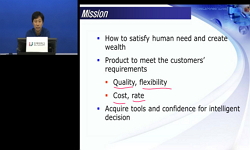자율주행 시스템의 안전성 검증과 주행 시험에 시뮬레이터를 적극 활용한다. 자율주행 시뮬레이터를 이용하여 검증하려면 차량 탑재 센서들에 대한 데이터 시뮬레이션이 정확해야 한다. 대...
http://chineseinput.net/에서 pinyin(병음)방식으로 중국어를 변환할 수 있습니다.
변환된 중국어를 복사하여 사용하시면 됩니다.
- 中文 을 입력하시려면 zhongwen을 입력하시고 space를누르시면됩니다.
- 北京 을 입력하시려면 beijing을 입력하시고 space를 누르시면 됩니다.
https://www.riss.kr/link?id=A107969932
- 저자
- 발행기관
- 학술지명
- 권호사항
-
발행연도
2021
-
작성언어
Korean
- 주제어
-
등재정보
KCI등재
-
자료형태
학술저널
- 발행기관 URL
-
수록면
3-13(11쪽)
-
KCI 피인용횟수
0
- DOI식별코드
- 제공처
-
0
상세조회 -
0
다운로드
부가정보
국문 초록 (Abstract)
자율주행 시스템의 안전성 검증과 주행 시험에 시뮬레이터를 적극 활용한다. 자율주행 시뮬레이터를 이용하여 검증하려면 차량 탑재 센서들에 대한 데이터 시뮬레이션이 정확해야 한다. 대표적인 차량 탑재 센서로써 라이다는 이미 현장에서 많이 활용되고 있지만 이에 대한 시뮬레이터는 아직 많은 한계가 있다. 다양한 특성의 중저가 라이다 센서들이 출시되면서 예전에 개발된 단순화된 범용 시뮬레이터가 제대로 지원하지 못하는 경우가 많다. 이에 본 연구는 범용 시뮬레이터가 아닌 실제 차량에 탑재된 특정한 라이다를 정밀하게 모사하는 시뮬레이터를 개발하고자 한다. 라이다의 동작 특성에 대한 센서 모델을 기하 모델과 복사 모델로 구성하고, 각각에 대해 실측 라이다 데이터에 포함되는 오차요소를 고려한 정밀한 모델을 제안하였다. 제안된 모델에 기반하여 유니티 엔진과 환경을 활용하여 효율적인 시뮬레이터를 구현하였다. 통제된 실험 공간에서 취득한 실측 데이터를 개발된 시뮬레이터로 생성한 데이터와 비교하여 시뮬레이터의 성능을 검증하였다. 실측 데이터와 비교한 결과 제안된 정밀 모델에 기반한 시뮬레이션 데이터는 기하와 복사 측면에서 유의미하게 향상된 유사도를 보였다. 본 연구의 실측 기반 검증을 통해 자율주행 시뮬레이터를 위한 신뢰성 있는 라이다 센서 모델을 개발할 수 있을 것으로 기대된다.
다국어 초록 (Multilingual Abstract)
The autonomous driving simulator is actively used for safety verification and driving tests of autonomous driving systems. To verify using an autonomous driving simulator, data simulation for vehicle sensors must be accurate. As a representative vehic...
The autonomous driving simulator is actively used for safety verification and driving tests of autonomous driving systems. To verify using an autonomous driving simulator, data simulation for vehicle sensors must be accurate. As a representative vehicle-mounted sensor, LIDAR is already widely used in the field, but the simulator for LIDAR sensors still has many limitations. As mid-to-low-priced LIDAR sensors with various characteristics are released, the simplified general-purpose simulator developed in the past often fails to properly support it. Therefore, in this study, we aim to develop a simulator that precisely simulates a specific lidar mounted on an actual vehicle, not a general-purpose simulator. The sensor model for the operation characteristics of LIDAR is composed of a geometric model and a radiometric model, and for each, a precise model is proposed considering the error factors included in the real LIDAR data. Based on the proposed model, an efficient simulator was implemented using the Unity engine. The performance of the simulator was verified by comparing the real data acquired in the controlled experimental site with the data generated by the developed simulator. As a result of comparison with the actual data, the simulation data based on the proposed precise model showed significantly improved similarity in terms of geometry and radiation. It is expected that a reliable LIDAR sensor model for an autonomous driving simulator can be developed through the actual measurement-based verification of this study.
목차 (Table of Contents)
- 要旨
- Abstract
- 1. 서론
- 2. 라이다 모델링
- 3. 라이다 시뮬레이션
- 要旨
- Abstract
- 1. 서론
- 2. 라이다 모델링
- 3. 라이다 시뮬레이션
- 4. 결과 분석
- 5. 결론
- References
참고문헌 (Reference)
1 "Velodyne LIDAR VLP-16 user manual"
2 Lee, G., "Validation of LIDAR calibration using a LIDAR simulator, The International Archives of Photogrammetry" 43 : 39-44, 2020
3 Wong, K., "Testing the safety of self-driving vehicles by simulating perception and prediction" Springer International Publishing 26 (26): 312-329, 2020
4 Xu, T., "Terrestrial laser scanning intensity correction by piecewise fitting and overlap-driven adjustment" 9 (9): 1-16, 2017
5 Glennie, C., "Static calibration and analysis of the Velodyne HDL-64E S2 for high accuracy mobile scanning" 2 (2): 1610-1624, 2010
6 Schlager, B., "State-of-the-art sensor models for virtual testing of advanced driver assistance systems/autonomous driving functions" 2020 (2020): 233-261, 2020
7 Wagner, W., "Radiometric calibration of small-footprint full-waveform airborne laser scanner measurements : basic physical concepts" 65 (65): 505-513, 2010
8 Khan, S., "Modeling laser intensities for simultaneous localization and mapping" 1 (1): 692-699, 2016
9 Li, Y., "Lidar for autonomous driving : the principles, challenges, and trends for automotive lidar and perception systems" 37 (37): 50-61, 2020
10 Vacek, P., "Learning to predict lidar intensities" 1-9, 2021
1 "Velodyne LIDAR VLP-16 user manual"
2 Lee, G., "Validation of LIDAR calibration using a LIDAR simulator, The International Archives of Photogrammetry" 43 : 39-44, 2020
3 Wong, K., "Testing the safety of self-driving vehicles by simulating perception and prediction" Springer International Publishing 26 (26): 312-329, 2020
4 Xu, T., "Terrestrial laser scanning intensity correction by piecewise fitting and overlap-driven adjustment" 9 (9): 1-16, 2017
5 Glennie, C., "Static calibration and analysis of the Velodyne HDL-64E S2 for high accuracy mobile scanning" 2 (2): 1610-1624, 2010
6 Schlager, B., "State-of-the-art sensor models for virtual testing of advanced driver assistance systems/autonomous driving functions" 2020 (2020): 233-261, 2020
7 Wagner, W., "Radiometric calibration of small-footprint full-waveform airborne laser scanner measurements : basic physical concepts" 65 (65): 505-513, 2010
8 Khan, S., "Modeling laser intensities for simultaneous localization and mapping" 1 (1): 692-699, 2016
9 Li, Y., "Lidar for autonomous driving : the principles, challenges, and trends for automotive lidar and perception systems" 37 (37): 50-61, 2020
10 Vacek, P., "Learning to predict lidar intensities" 1-9, 2021
11 Hanke, T., "Generation and validation of virtual point cloud data for automated driving systems" IEEE 1-6, 2017
12 Elmadawi, K., "End-to-end sensor modeling for LiDAR point cloud" IEEE 1619-1624, 2019
13 Tan, K., "Distance effect correction on TLS intensity data using naturally homogeneous targets" 17 (17): 499-503, 2019
14 Gusmão, G. F., "Development and validation of LIDAR sensor simulators based on parallel raycasting" 20 (20): 1-19, 2020
15 Li, Y., "Deep learning for LiDAR point clouds in autonomous driving: a review" 1-21, 2020
16 Holder, M. F., "Data-driven derivation of requirements for a lidar sensor model" 1-10, 2018
17 Carrea, D., "Correction of terrestrial LiDAR intensity channel using oren–nayar reflectance model : an application to lithological differentiation" 113 : 17-29, 2016
18 Tan, K., "Correction of incidence angle and distance effects on TLS intensity data based on reference targets" 8 (8): 1-20, 2016
19 Rosique, F., "A systematic review of perception system and simulators for autonomous vehicles research" 19 (19): 1-29, 2019
20 Yue, X., "A lidar point cloud generator: from a virtual world to autonomous driving" Association for Computing Machinery 458-464, 2018
동일학술지(권/호) 다른 논문
-
공간정보 기반의 수자원 관리를 위한 주요 지표의 중요도 평가
- 대한공간정보학회
- 정다운(Jeong, Da Woon)
- 2021
- KCI등재
-
텍스처 영상의 폐색영역 해결을 위한 영상 인페인팅 알고리즘 적용 기술연구
- 대한공간정보학회
- 이정민(Lee, Jeong Min)
- 2021
- KCI등재
-
- 대한공간정보학회
- 서동조(Seo, Dong Jo)
- 2021
- KCI등재
-
드론 및 AI를 이용한 해안 쓰레기 모니터링 체계: 제주도 사례 중심으로
- 대한공간정보학회
- 최경아(Choi, Kyoungah)
- 2021
- KCI등재
분석정보
인용정보 인용지수 설명보기
학술지 이력
| 연월일 | 이력구분 | 이력상세 | 등재구분 |
|---|---|---|---|
| 2027 | 평가예정 | 재인증평가 신청대상 (재인증) | |
| 2021-01-01 | 평가 | 등재학술지 유지 (재인증) |  |
| 2019-03-12 | 학술지명변경 | 한글명 : 한국지형공간정보학회지 -> 대한공간정보학회지외국어명 : Journal of The Korea Society For Geospatial Information Science -> journal of Korean Society for Geospatial Information Science |  |
| 2019-01-29 | 학회명변경 | 한글명 : 한국공간정보학회 -> 대한공간정보학회 |  |
| 2018-01-01 | 평가 | 등재학술지 유지 (등재유지) |  |
| 2015-03-30 | 학술지명변경 | 외국어명 : The Korea Society For GeospatIal Information System -> Journal of The Korea Society For Geospatial Information Science |  |
| 2015-01-01 | 평가 | 등재학술지 유지 (등재유지) |  |
| 2013-01-02 | 학술지명변경 | 한글명 : 한국지형공간 정보학회지 -> 한국지형공간정보학회지 |  |
| 2011-01-01 | 평가 | 등재학술지 유지 (등재유지) |  |
| 2010-05-07 | 학회명변경 | 한글명 : 한국GIS학회 -> 한국공간정보학회영문명 : Geographic Information Systems Association Of Korea -> Korea Spatial Information Society (KSIS) |  |
| 2008-01-01 | 평가 | 등재학술지 선정 (등재후보2차) |  |
| 2007-01-01 | 평가 | 등재후보 1차 PASS (등재후보1차) |  |
| 2005-01-01 | 평가 | 등재후보학술지 선정 (신규평가) |  |
학술지 인용정보
| 기준연도 | WOS-KCI 통합IF(2년) | KCIF(2년) | KCIF(3년) |
|---|---|---|---|
| 2016 | 0.83 | 0.83 | 0.72 |
| KCIF(4년) | KCIF(5년) | 중심성지수(3년) | 즉시성지수 |
| 0.63 | 0.61 | 0.947 | 0.12 |





 DBpia
DBpia



